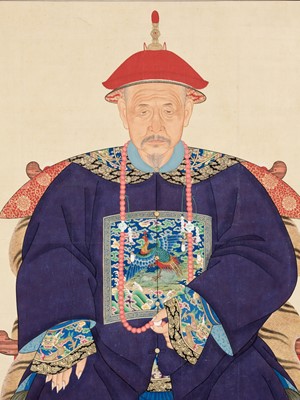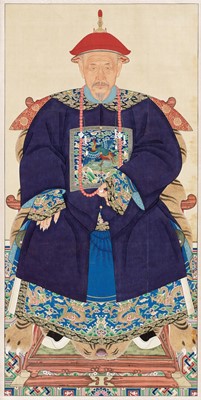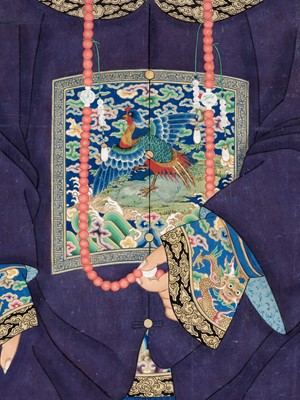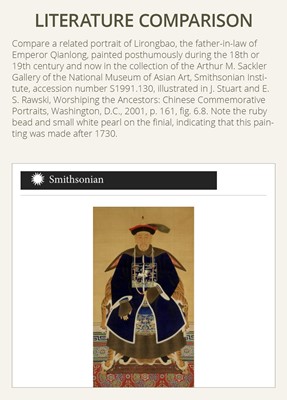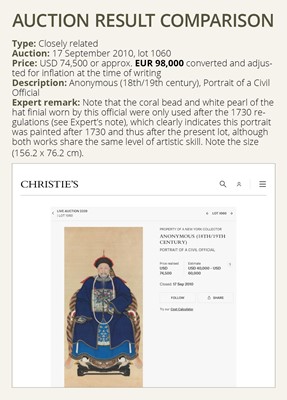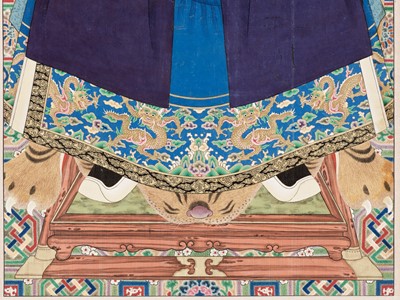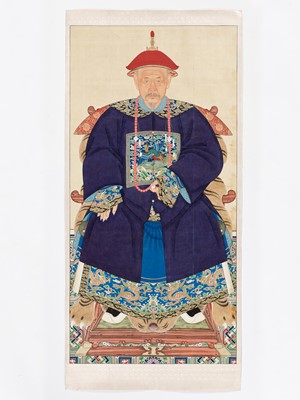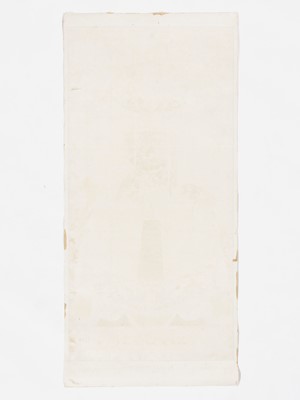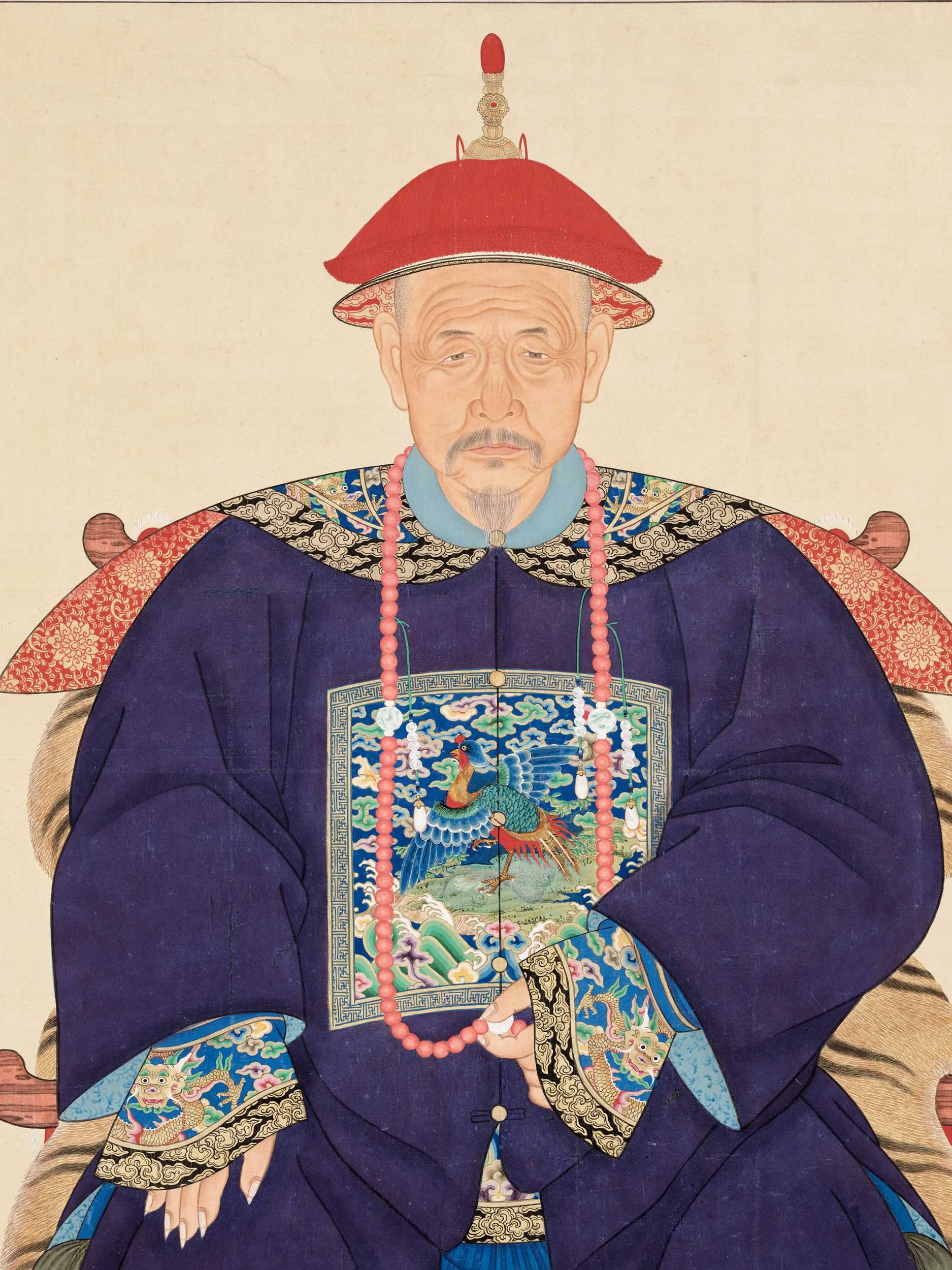29th Sep, 2022 13:00
DAY 1 - TWO-DAY AUCTION - Fine Chinese Art / 中國藝術集珍 / Buddhism & Hinduism
197
A SPECTACULAR PORTRAIT OF A SECOND-RANK CIVIL OFFICIAL, IMPERIAL SCHOOL, YONGZHENG, PRE-1730
雍正時期二品官員肖像畫
Sold for €13,000
including Buyer's Premium
Expert’s note: Before the Yongzheng Emperor’s new regulations for hat finials in 1730, first-rank officials used a ruby bead and small white pearl, while second-rank officials wore a ruby bead and a small red gemstone. Afterwards, first-rank officials’ finials were set with translucent red glass or ruby beads, while those of second-rank officials held coral beads or red glass in imitation of coral, with both using small white pearls. The hat finial of the present official is clearly set with a ruby and not a coral bead, which is evidenced by the paler color of his coral necklace, as well as a smaller red stone. Therefore, this portrait must have been painted before the 1730 regulations were put in place. For more information on Qing-dynasty hat finial regulations before and after 1730, see Gary Dickinson & Linda Wrigglesworth, Imperial Wardrobe, London, 1990, page 106.
China, before 1730. Ink, gilt, and watercolors on silk, with a silk brocade frame and laid down on paper. The elderly aristocrat wearing a red official hat (chao guan) with a gold finial holding a large ruby and a smaller red gemstone. Note the exceptional quality of the painting and remarkable attention to detail – as found for example on the silk rug with its distinct forbidden stitch, the gilt-outlined swirling clouds on the rank badge, and the robe hems, which all appear strikingly lifelike.
Provenance: Chicago trade, USA, sold for the benefit of a noted cultural nonprofit organization. European trade, acquired from the above.
Condition: Very good condition with only minor wear, some soiling, little creasing, small losses, few minor touchups.
Dimensions: Image size 155.6 x 77 cm, Size incl. mounting 175 x 80.8 cm
Seated on a fine wooden yokeback chair with a tiger skin seat cover, wearing a midnight blue surcoat (pu fu) over a blue silk formal court robe (chao fu), the collar of the surcoat and hems of the robe decorated with sinuous dragons amid colorful clouds, matching the golden pheasant rank badge, his left hand holding a white pearl from his coral court necklace between two fingers, the realistically treated face marked by heavy-lidded eyes, deep wrinkles, and a gray mustache and beard. Note the texture of the soft fur of the tiger's pelt and coat edges, as well as the rough quality of the embroidered cloud-scroll bands of the coat cuffs.
At the beginning of the Qing dynasty, the chao guan was worn on semi-formal occasions without its usual ornate spike. The Yongzheng Emperor appears to have felt that this was unsatisfactory. Easily identified hat finials were introduced in 1727 by the Yongzheng Emperor and were worn on all official and public occasions. The new insignia was a large round bead of material of the appropriate color, along with a smaller pearl or stone of the same color as the bead, mounted on a gilt base. The highest-ranking officials wore plain opaque red beads, while the lowest wore silver. In 1730, regulations were introduced to allow the use of colored glass instead of precious stones.
Literature comparison:
Compare a related portrait of Lirongbao, the father-in-law of Emperor Qianlong, painted posthumously during the 18th or 19th century and now in the collection of the Arthur M. Sackler Gallery of the National Museum of Asian Art, Smithsonian Institute, accession number S1991.130, illustrated in J. Stuart and E. S. Rawski, Worshiping the Ancestors: Chinese Commemorative Portraits, Washington, D.C., 2001, p. 161, fig. 6.8. Note the ruby bead and small white pearl on the finial, indicating that this painting was made after 1730.
Auction result comparison:
Type: Closely related
Auction: 17 September 2010, lot 1060
Price: USD 74,500 or approx. EUR 98,000 converted and adjusted for inflation at the time of writing
Description: Anonymous (18th/19th century), Portrait of a Civil Official
Expert remark: Note that the coral bead and white pearl of the hat finial worn by this official were only used after the 1730 regulations (see Expert’s note), which clearly indicates this portrait was painted after 1730 and thus after the present lot, although both works share the same level of artistic skill. Note the size (156.2 x 76.2 cm).
雍正時期二品官員肖像畫
中國,1730年前。絹本設色描金。文官頭戴金頂朝冠,左手扶朝珠;眼睛微垂,深邃的皺紋,灰白的鬍子。坐於鋪著虎皮的木椅上,身著深藍色外衣。請注意虎皮和外套邊緣的柔軟毛皮的質地,以及外套袖口的刺繡雲卷帶的粗糙質量。請注意這幅畫的精美細節——例如衣領、補子、袖口以及地毯,虎皮顯得十分柔軟、栩栩如生。
專家注釋:1730年雍正皇帝頒布帽飾新規之前,一品官佩戴紅寶石珠和小白珠,二品官佩戴紅寶石珠和小紅寶石。之後,一品官的頭飾上鑲有半透明的紅玻璃或紅寶石珠,二品官員則戴珊瑚珠或仿珊瑚的紅玻璃,均用白色的小珍珠。拍品上的官員的朝冠上顯然鑲有紅寶石,而不是珊瑚珠,這從他的珊瑚項鍊的顏色較淡,以及一顆較小的紅色石頭就可以看出這一點。 因此,這幅肖像一定是在 1730 年的法規實施之前繪製的。有關 1730 年前後清朝帽飾規定的更多信息,參見 Gary Dickinson 和 Linda Wrigglesworth,Imperial Wardrobe,倫敦,1990年,頁106。
來源:美國芝加哥古玩交易,為資助一個知名的非盈利文化組織;歐洲古玩交易。
品相:狀況極好,只有輕微磨損、一些污漬、少量摺痕、缺損和修補。
尺寸:畫面155.6 x 77 厘米,總175 x 80.8 厘米
文獻比較:
比較一件相近的乾隆皇帝岳父李榮保畫作,可能畫於十八或十九世紀,現藏於亞瑟·M·賽克勒美術館,史密森尼學會,編號 S1991.130,見J. Stuart和E. S. Rawski,《Worshiping the Ancestors: Chinese Commemorative Portraits》,華盛頓D.C.,2001年,頁161,圖6.8。請注意佩戴的紅寶石珠和白色的小珍珠,斷定肖像一定是在 1730 年後繪製的。
拍賣結果比較:
形制:非常相近
拍賣:2010年9月17日,lot 1060
價格:USD 74,500(相當於今日EUR 98,000)
描述:十八至十九世紀官員肖像畫
專家評論:請注意官帽上的珊瑚珠和白色的小珍珠,可以確定此畫是畫於1730 年的法規實施之後(見專家註釋),雖然有相同等級的繪畫技巧,但年代晚於現拍品。請注意尺寸 (156.2 x 76.2厘米)。
Expert’s note: Before the Yongzheng Emperor’s new regulations for hat finials in 1730, first-rank officials used a ruby bead and small white pearl, while second-rank officials wore a ruby bead and a small red gemstone. Afterwards, first-rank officials’ finials were set with translucent red glass or ruby beads, while those of second-rank officials held coral beads or red glass in imitation of coral, with both using small white pearls. The hat finial of the present official is clearly set with a ruby and not a coral bead, which is evidenced by the paler color of his coral necklace, as well as a smaller red stone. Therefore, this portrait must have been painted before the 1730 regulations were put in place. For more information on Qing-dynasty hat finial regulations before and after 1730, see Gary Dickinson & Linda Wrigglesworth, Imperial Wardrobe, London, 1990, page 106.
China, before 1730. Ink, gilt, and watercolors on silk, with a silk brocade frame and laid down on paper. The elderly aristocrat wearing a red official hat (chao guan) with a gold finial holding a large ruby and a smaller red gemstone. Note the exceptional quality of the painting and remarkable attention to detail – as found for example on the silk rug with its distinct forbidden stitch, the gilt-outlined swirling clouds on the rank badge, and the robe hems, which all appear strikingly lifelike.
Provenance: Chicago trade, USA, sold for the benefit of a noted cultural nonprofit organization. European trade, acquired from the above.
Condition: Very good condition with only minor wear, some soiling, little creasing, small losses, few minor touchups.
Dimensions: Image size 155.6 x 77 cm, Size incl. mounting 175 x 80.8 cm
Seated on a fine wooden yokeback chair with a tiger skin seat cover, wearing a midnight blue surcoat (pu fu) over a blue silk formal court robe (chao fu), the collar of the surcoat and hems of the robe decorated with sinuous dragons amid colorful clouds, matching the golden pheasant rank badge, his left hand holding a white pearl from his coral court necklace between two fingers, the realistically treated face marked by heavy-lidded eyes, deep wrinkles, and a gray mustache and beard. Note the texture of the soft fur of the tiger's pelt and coat edges, as well as the rough quality of the embroidered cloud-scroll bands of the coat cuffs.
At the beginning of the Qing dynasty, the chao guan was worn on semi-formal occasions without its usual ornate spike. The Yongzheng Emperor appears to have felt that this was unsatisfactory. Easily identified hat finials were introduced in 1727 by the Yongzheng Emperor and were worn on all official and public occasions. The new insignia was a large round bead of material of the appropriate color, along with a smaller pearl or stone of the same color as the bead, mounted on a gilt base. The highest-ranking officials wore plain opaque red beads, while the lowest wore silver. In 1730, regulations were introduced to allow the use of colored glass instead of precious stones.
Literature comparison:
Compare a related portrait of Lirongbao, the father-in-law of Emperor Qianlong, painted posthumously during the 18th or 19th century and now in the collection of the Arthur M. Sackler Gallery of the National Museum of Asian Art, Smithsonian Institute, accession number S1991.130, illustrated in J. Stuart and E. S. Rawski, Worshiping the Ancestors: Chinese Commemorative Portraits, Washington, D.C., 2001, p. 161, fig. 6.8. Note the ruby bead and small white pearl on the finial, indicating that this painting was made after 1730.
Auction result comparison:
Type: Closely related
Auction: 17 September 2010, lot 1060
Price: USD 74,500 or approx. EUR 98,000 converted and adjusted for inflation at the time of writing
Description: Anonymous (18th/19th century), Portrait of a Civil Official
Expert remark: Note that the coral bead and white pearl of the hat finial worn by this official were only used after the 1730 regulations (see Expert’s note), which clearly indicates this portrait was painted after 1730 and thus after the present lot, although both works share the same level of artistic skill. Note the size (156.2 x 76.2 cm).
雍正時期二品官員肖像畫
中國,1730年前。絹本設色描金。文官頭戴金頂朝冠,左手扶朝珠;眼睛微垂,深邃的皺紋,灰白的鬍子。坐於鋪著虎皮的木椅上,身著深藍色外衣。請注意虎皮和外套邊緣的柔軟毛皮的質地,以及外套袖口的刺繡雲卷帶的粗糙質量。請注意這幅畫的精美細節——例如衣領、補子、袖口以及地毯,虎皮顯得十分柔軟、栩栩如生。
專家注釋:1730年雍正皇帝頒布帽飾新規之前,一品官佩戴紅寶石珠和小白珠,二品官佩戴紅寶石珠和小紅寶石。之後,一品官的頭飾上鑲有半透明的紅玻璃或紅寶石珠,二品官員則戴珊瑚珠或仿珊瑚的紅玻璃,均用白色的小珍珠。拍品上的官員的朝冠上顯然鑲有紅寶石,而不是珊瑚珠,這從他的珊瑚項鍊的顏色較淡,以及一顆較小的紅色石頭就可以看出這一點。 因此,這幅肖像一定是在 1730 年的法規實施之前繪製的。有關 1730 年前後清朝帽飾規定的更多信息,參見 Gary Dickinson 和 Linda Wrigglesworth,Imperial Wardrobe,倫敦,1990年,頁106。
來源:美國芝加哥古玩交易,為資助一個知名的非盈利文化組織;歐洲古玩交易。
品相:狀況極好,只有輕微磨損、一些污漬、少量摺痕、缺損和修補。
尺寸:畫面155.6 x 77 厘米,總175 x 80.8 厘米
文獻比較:
比較一件相近的乾隆皇帝岳父李榮保畫作,可能畫於十八或十九世紀,現藏於亞瑟·M·賽克勒美術館,史密森尼學會,編號 S1991.130,見J. Stuart和E. S. Rawski,《Worshiping the Ancestors: Chinese Commemorative Portraits》,華盛頓D.C.,2001年,頁161,圖6.8。請注意佩戴的紅寶石珠和白色的小珍珠,斷定肖像一定是在 1730 年後繪製的。
拍賣結果比較:
形制:非常相近
拍賣:2010年9月17日,lot 1060
價格:USD 74,500(相當於今日EUR 98,000)
描述:十八至十九世紀官員肖像畫
專家評論:請注意官帽上的珊瑚珠和白色的小珍珠,可以確定此畫是畫於1730 年的法規實施之後(見專家註釋),雖然有相同等級的繪畫技巧,但年代晚於現拍品。請注意尺寸 (156.2 x 76.2厘米)。
Zacke Live Online Bidding
Our online bidding platform makes it easier than ever to bid in our auctions! When you bid through our website, you can take advantage of our premium buyer's terms without incurring any additional online bidding surcharges.
To bid live online, you'll need to create an online account. Once your account is created and your identity is verified, you can register to bid in an auction up to 12 hours before the auction begins.
Intended Spend and Bid Limits
When you register to bid in an online auction, you will need to share your intended maximum spending budget for the auction. We will then review your intended spend and set a bid limit for you. Once you have pre-registered for a live online auction, you can see your intended spend and bid limit by going to 'Account Settings' and clicking on 'Live Bidding Registrations'.
Your bid limit will be the maximum amount you can bid during the auction. Your bid limit is for the hammer price and is not affected by the buyer’s premium and VAT. For example, if you have a bid limit of €1,000 and place two winning bids for €300 and €200, then you will only be able to bid €500 for the rest of the auction. If you try to place a bid that is higher than €500, you will not be able to do so.
Online Absentee and Telephone Bids
You can now leave absentee and telephone bids on our website!
Absentee Bidding
Once you've created an account and your identity is verified, you can leave your absentee bid directly on the lot page. We will contact you when your bids have been confirmed.
Telephone Bidding
Once you've created an account and your identity is verified, you can leave telephone bids online. We will contact you when your bids have been confirmed.
Classic Absentee and Telephone Bidding Form
You can still submit absentee and telephone bids by email or fax if you prefer. Simply fill out the Absentee Bidding/Telephone bidding form and return it to us by email at office@zacke.at or by fax at +43 (1) 532 04 52 20. You can download the PDF from our Upcoming Auctions page.
How-To Guides
How to Create Your Personal Zacke Account
How to Register to Bid on Zacke Live
How to Leave Absentee Bids Online
How to Leave Telephone Bids Online
中文版本的操作指南
创建新账号
注册Zacke Live在线直播竞拍(免平台费)
缺席投标和电话投标
Third-Party Bidding
We partner with best-in-class third-party partners to make it easy for you to bid online in the channel of your choice. Please note that if you bid with one of our third-party online partners, then there will be a live bidding surcharge on top of your final purchase price. You can find all of our fees here. Here's a full list of our third-party partners:
- 51 Bid Live
- EpaiLive
- ArtFoxLive
- Invaluable
- LiveAuctioneers
- the-saleroom
- lot-tissimo
- Drouot
Please note that we place different auctions on different platforms. For example, in general, we only place Chinese art auctions on 51 Bid Live.
Bidding in Person
You must register to bid in person and will be assigned a paddle at the auction. Please contact us at office@zacke.at or +43 (1) 532 04 52 for the latest local health and safety guidelines.
